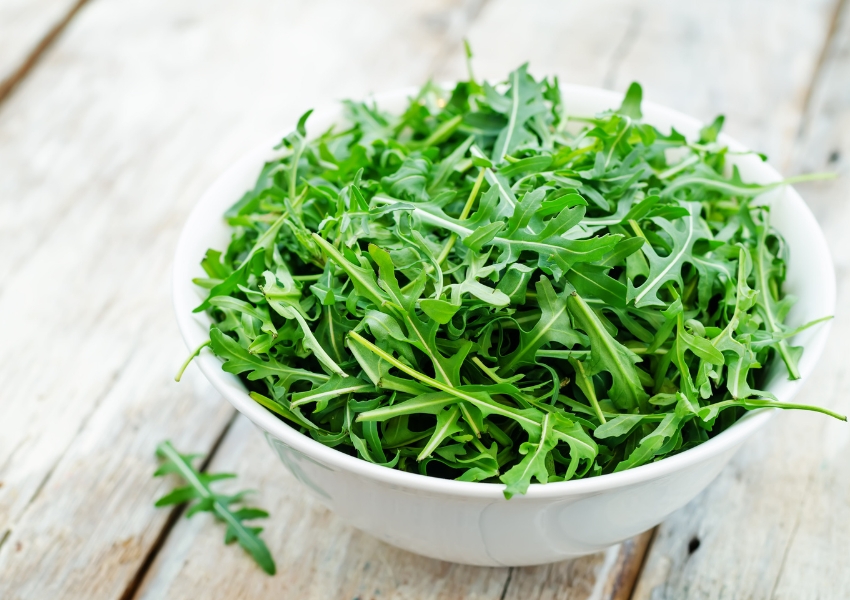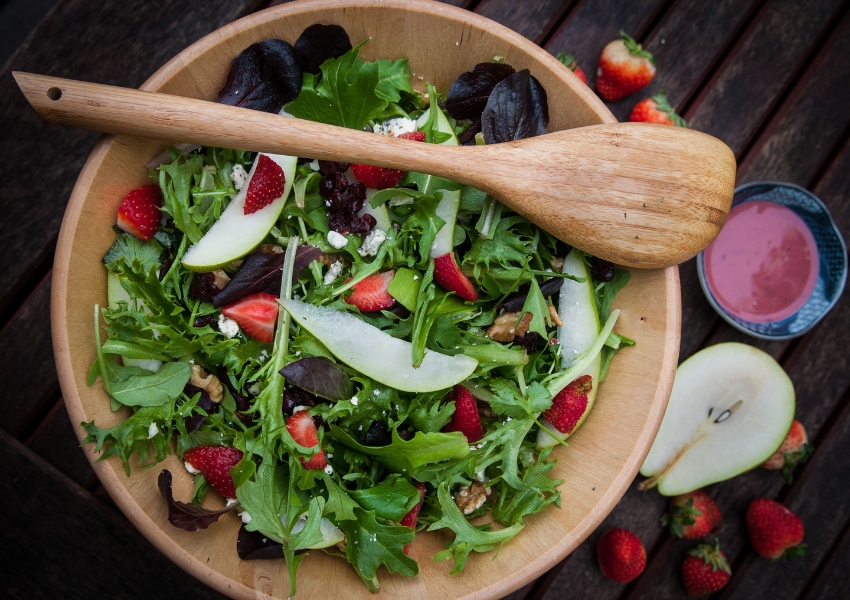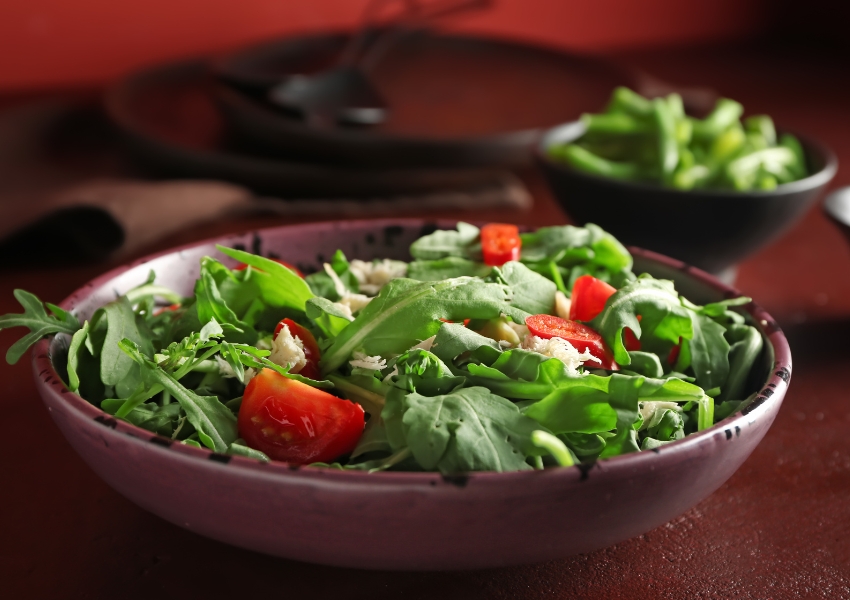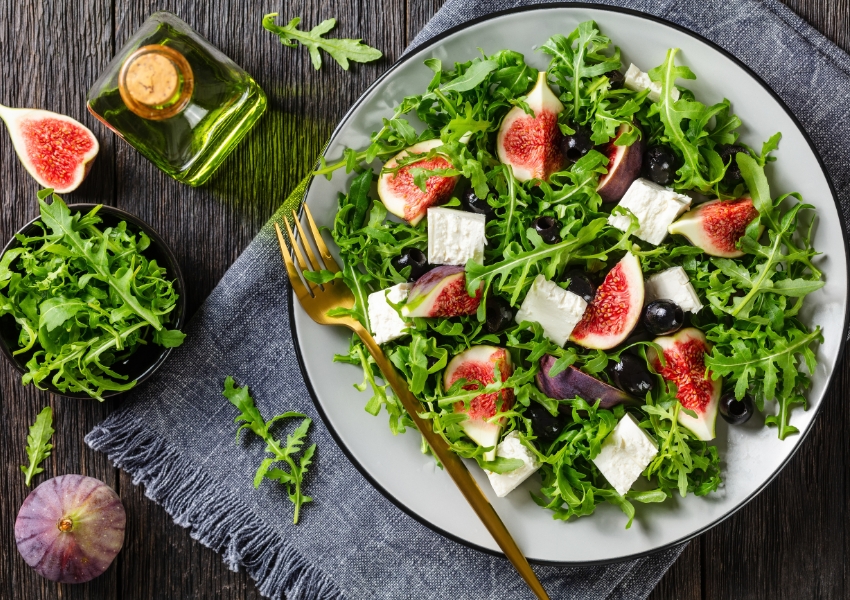The Rocca salad, a delightful Middle Eastern dish, features a combination of rocket (jarjeer), onion, walnuts, and a tangy sumac lemon dressing. You can savor this rocca salad as it is or enhance it further by adding your preferred selection of vegetables.
Rocca, a commonly used green in the Middle East, is a staple ingredient in many Lebanese restaurants. It is frequently served as an appetizer or side dish on almost every dining table. You can enjoy Rocca in its pure form as fresh leaves, which I love to munch on or incorporate into a flavorful salad like the one featured here.
What is Jarjeer?
In Arabic, arugula is referred to as “jarjeer” and is pronounced as “jarr-jeerr” with a rolled “r” sound. The leaves of jarjeer are also known as “gerger leaves.”
You may recognize this leafy green as arugula, rocket, or roquette in English, commonly used in Arabic salads.
Arugula, also known as salad rocket, offers many health benefits. It protects your heart, aids in weight control, improves eye health, reduces cancer risk, supports digestion, helps control blood pressure, may prevent diabetes, promotes healthy bones with its vitamin K and calcium content, benefits the skin, may contribute to longevity, enhances athletic performance, acts as a detoxifier, reduces inflammation in the body, and may improve cognitive function.

Once considered exotic, arugula has become a mainstream ingredient adding a peppery dimension to various dishes such as salads, soups, pizzas, and omelets.
Native to the Mediterranean region, this leafy green vegetable belongs to the Eruca genus in the Brassicaceae family. Apart from the dark green leaves, the seeds, seed oil, and arugula flowers are also edible.
From a nutritional standpoint, arugula is highly beneficial. A whole cup (100g) of fresh arugula leaves contains:
- Only 25 calories.
- 3.65 grams of carbohydrates.
- Approximately 2.5 grams of protein.
- 1.6 grams of dietary fiber.
Arugula also contains essential vitamins such as C, A, K, and folate. In terms of minerals, it provides notable amounts of calcium, potassium, magnesium, phosphorus, zinc, and iron.
Incorporating arugula into your meals allows you to enjoy its exceptional taste while reaping its numerous health advantages.
15 Health Benefits of Jarjeer (Arugula)
Here are 15 remarkable health benefits of arugula:
- Protects Your Heart: Arugula’s vitamin C, vitamin K, and folate content contribute to heart health by reducing inflammation and maintaining healthy blood vessels.
- Helps Control Weight: Being low in calories and high in fiber, arugula can support weight management and provide essential nutrients.
- Improves Eye Health: Rich in beta-carotene, lutein, and zeaxanthin, arugula promotes good vision and protects against age-related macular degeneration.
- Reduces Cancer Risk: The glucosinolates in arugula may help prevent cancer by neutralizing harmful chemicals and promoting cell death in cancer cells.
- Suitable for Pregnant Women: Arugula’s high folate content benefits fetal development and helps prevent neural tube defects.
- Helps With Digestion: Arugula’s fluid and fiber content supports healthy digestion, reduces digestive disorders’ risk, and improves gut health.
- Helps Control Blood Pressure: Arugula’s calcium, magnesium, and potassium content contribute to maintaining healthy blood pressure levels.
- Helps Prevent Diabetes: Arugula’s low sugar and carbohydrate content make it suitable for individuals with diabetes or those at risk of developing the condition.
- Delivers Vitamin K and Calcium for Healthy Bones: Arugula provides calcium and vitamin K, essential for bone health and osteoporosis prevention.
- It is Good for Your Skin: Arugula’s antioxidants and anti-inflammatory compounds promote healthy skin, protect against UV damage, and help reduce signs of aging.
- May Add Years to Your Life: The nutrient density of arugula, including omega-3s, antioxidants, and vitamins, may contribute to longevity and reduce mortality rates.
- Enhances Athletic Performance: Arugula’s nitrate content improves oxygen flow to muscles, potentially enhancing endurance during exercise and promoting cartilage growth.
- Arugula is a Great Detoxifier: Arugula’s vitamin C, chlorophyll, and antioxidants aid in detoxification by neutralizing toxins and promoting liver health.
- Helps Reduce Inflammation in the Body: Arugula’s anti-inflammatory properties can help reduce inflammation-related pain associated with arthritis.
- May Improve Cognitive Function: Arugula’s folate content may slow cognitive decline in older people and support brain health.
WHAT IS SALATAT JARJEER?
Salatat jarjeer, a delightful salad made with arugula leaves (rocket), is a popular dish in Middle Eastern and Mediterranean cuisine.
This salad boasts a unique combination of flavors. The arugula leaves contribute a naturally peppery taste, while the tanginess comes from adding lemon juice. The aromatic sumac adds a delightful fragrance, and the walnut kernels provide a protein-rich element. Finely-sliced onion adds a pleasant crunch to the salad.

Salatat jarjeer can be enjoyed as a refreshing standalone dish or served as a side alongside other main courses like lamb skewers. It also pairs wonderfully with seafood dishes lightly sautéed in olive oil and garlic or served alongside flavorful dips such as hummus.
Indulge in the vibrant flavors of Salatat jarjeer and savor the distinct taste of Middle Eastern and Mediterranean cuisine.
WHY YOU’LL LOVE THIS RECIPE
- This dish offers a delightful combination of juiciness and sourness with minimal ingredients.
- It complements various flavors, making it a versatile pairing for multiple dishes.
- You can customize the recipe by adding vegetables or enjoying it. See variations below for inspiration.
- This dish suits those following a gluten-free, soy-free, and corn-free diet.
WHAT YOU’LL NEED
- Salt
- Olive Oil
- Onion
- Sumac
- Lemon
- Walnuts
- Arugula
INGREDIENTS NOTES
Jarjeer (rocket) is available in various types, including large and small rocca leaves and wild rockets. All variations are fantastic choices.
The larger and wild Rocca leaves tend to have a more robust flavor profile. Jarjeer itself is known for its peppery taste.
If using larger rocca leaves, chop them into bite-sized pieces. The smaller and wild leaves can be used as is.
For onions, either white or red varieties work well. I prefer white onions for their sweeter taste. It is essential to slice the onions thinly.
When using walnuts, opt for raw ones and roughly chop them. Dry roast the walnuts in a frying pan until they turn golden. Allow them to cool to room temperature before adding them to the other ingredients.
The dressing for rocket salad consists of lemon, sumac, olive oil, and salt.
Sumac is a spice commonly grown across the Middle East, with a history spanning thousands of years. It is now widely available in supermarkets, local grocers, and online stores.
Sumac has a deep red color and imparts a sour and tangy flavor. Do not omit this ingredient, as it plays a crucial role in the flavor profile of the Rocca salad. If you cannot find sumac, substitute it with pomegranate molasses or balsamic vinegar. However, the flavor will be different but still enjoyable.
STEP-BY-STEP GUIDE
Here’s a simple recipe for making rocca salad:
Step 1: Heat a frying pan over high heat and add the walnuts. Dry roast them until they turn golden. Remove from heat and let them cool to room temperature.
Step 2: Combine the ingredients in a salad bowl, including the cooled walnuts. Toss everything together.
Step 3: You can serve the salad immediately or let it sit for 20 minutes or more, allowing the flavors to meld and the ingredients to soak up the delicious juices.
PRO TIPS
Rocca leaves have a remarkable ability to absorb dressing, and the longer the salad sits, the more succulent the leaves become.
To preserve the delicate nature of Rocca leaves, it’s best to use a salad spinner for gentle drying after washing. Rough handling can bruise them, which applies to any salads with rockets.
If you want to prepare ahead:
- Keep the chopped vegetables separate from the prepared rocket salad dressing (stored in a jar).
- Store the dry roasted walnuts in an airtight container in the pantry.
- When you’re ready, combine all the ingredients.
Following these tips, you can ensure your rocca salad remains fresh and at its best when served.
VARIATIONS
This versatile rocca salad can serve as a base that can be customized based on other available ingredients or personal preferences. Depending on what you have on hand, you can add any of the following to the base salad (adjusting the dressing accordingly):
Button mushrooms: I recommend quartering the smaller ones.
Pomegranate: A delightful addition that brings sweetness and crunch to rocket salads.
Pear or apple: Freshly cut slices of these fruits complement the flavors.
Beetroot: Cooked and peeled beetroots or canned ones work well.
Tomatoes: Any type of tomato, including sun-dried tomatoes, adds flavor.
Artichoke: Roasted, steamed, or marinated artichokes make a great addition.
To adjust the dressing for the rocket salad, you can incorporate pomegranate molasses or balsamic vinegar/glaze.
Feel free to omit the walnuts if desired.
With these variations, you can create a delightful and personalized rocca salad that suits your tastes and ingredient availability. Enjoy exploring the different flavor combinations!
Rocca Salad (Lebanese Salatat Jarjeer)

This Middle Eastern salad, also known as Rocca Salad or Salatat Jarjeer, features a delightful combination of flavors. It comprises arugula (roquette/Rocca), white onion, dry roasted walnuts, and optional pomegranate kernels. The salad has a tangy sumac lemon dressing that enhances its taste. Enjoy it as is, or customize it by adding your favorite vegetables. Here’s the recipe:
Ingredients:
- Four cups arugula (roquette/Rocca); if using a small variety, leave it as is. If using a large leaf variety, chop it up into bite-sized pieces.
- ½ medium white onion, finely sliced
- ½ cup dry roasted walnuts
- ¼ medium pomegranate, optional. Use kernels only.
Dressing for Rocca Salad:
- 1½ tablespoons extra virgin olive oil
- One teaspoon sumac
- ½ medium lemon, freshly juiced
- One pinch of salt, to taste
Instructions:
- Heat a frypan over high heat and add walnuts. Dry roast until golden. Please take off the heat and allow them to cool to room temperature.
- In a salad bowl, combine all the salad ingredients.
- Serve immediately, or let it sit for 20+ minutes to allow the flavors to meld together.
Notes:
- Rocca leaves are great at soaking up the dressing, so the longer the prepared salad sits, the juicier the leaves become.
- Gently dry the Rocca leaves in a salad spinner after washing to prevent bruising.
- To prepare ahead of time, keep the chopped vegetables separate from the dressing in the fridge. Store the dry roasted walnuts in an airtight container in the pantry. Combine all the ingredients when you’re ready to serve.
Variations:
- This Rocca Salad can be customized by adding additional ingredients such as button mushrooms, pomegranate, pear or apple slices, beetroot, tomatoes, and artichoke or adjusting the dressing to include pomegranate molasses or balsamic vinegar/glaze.
- Walnuts can be omitted if desired.
Serving Suggestions:
- Enjoy Rocca Salad as part of a larger meal, such as a mezze platter, or pair it with vegetarian kibbeh or soups like vegan potato and leek soup.
- It also complements vegetable and nut rice dishes.
Equipment:
- Bowl
Nutrition Information:
- Serving: 1g
- Calories: 129kcal
- Carbohydrates: 9g
- Protein: 3g
- Fat: 10g
- Saturated Fat: 1g
- Polyunsaturated Fat: 7g
- Monounsaturated Fat: 2g
- Sodium: 63mg
- Potassium: 220mg
- Fiber: 3g
- Sugar: 4g
- Vitamin A: 493IU
- Vitamin C: 13mg
- Calcium: 56mg
- Iron: 1mg
Note: The measurements provided are in US cups and spoons. 1 cup is equivalent to 240ml, 1 tablespoon is equivalent to 15ml, and 1 teaspoon is equivalent to 5ml.
Nutrition information is an estimate and may vary based on specific ingredients used.

